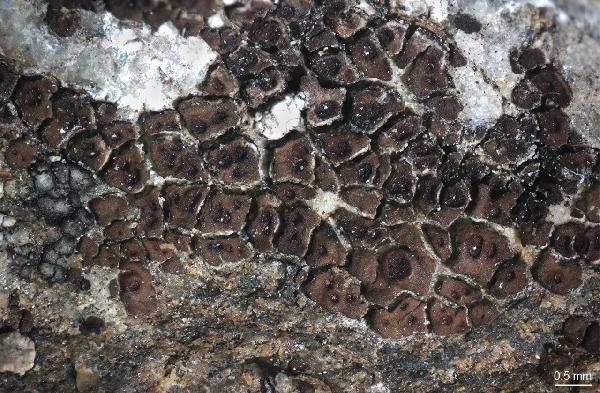Acarospora saxonica H. Magn.
K. svenska Vetensk-Akad. Handl., Ser. III, 7, 4: 182, 1929
Synonyms:
Distribution: N - TAA (Rettig & al. 2023).
Description: Thallus crustose, episubstratic, areolate, grey-brown to dark brown, forming 1-2 cm wide patches, the areoles 0.5-0.8(-1) mm wide and 260-430 μm thick; lower side pale to blackish. Epicortex poorly developed or up to 20 μm thick; cortex paraplectenchymatous, (20-)30-40(-50) μm thick, brown in the upper 10-15 μm, colourless in lower part, with 2-5 μm wide cells; algal layer continuous, (40-)65-145 μm thick, the algal cells 10-15 μm wide; medulla up to 200 μm thick, with c. 2 μm thick hyphae. Apothecia lecanorine, 0.4-0-7 mm across, immersed in the areoles or projecting with the raised thalline margin, with a reddish brown to blackish, smooth to rough disc and an up to 60 μm wide thalline margin. Thalline exciple rich in algae; proper exciple poorly developed, 20-30 μm wide; epithecium brown, 15-25 μm high; hymenium colourless, 100-135(-150) μm high; paraphyses (1-)1.7-2(-3) μm thick at mid-level, the apical cells sometimes slightly wider; subhymenium 10-30 μm high, the hymenial gel hemiamyloid, K/I+ light blue fading to light red; hypothecium poorly developed, up to 10 μm high. Asci >100-spored, clavate, the apical dome K/I-, 80-100 x 12-17 μm. Ascospores 1-celled, hyaline, narrowly ellipsoid to almost bacilliform, 3-4 x 0.5-1 μm, almost resembling conidia. Pycnidia not known. Photobiont chlorococcoid. Spot tests: cortex and medulla K-, C-, KC-, P-, UV-. Chemistry: without lichen substances. Note: a species known from Germany, Austria and Switzerland, recently also reported from Italy (South Tyrol), found on siliceous rocks, including anthropogenous substrata such as glass, from 300 to c. 2000 m. For further details see Rettig & al. (2023).
Growth form: Crustose
Substrata: rocks
Photobiont: green algae other than Trentepohlia
Reproductive strategy: mainly sexual
Commonnes-rarity: (info)
Alpine belt: absent
Subalpine belt: extremely rare
Oromediterranean belt: absent
Montane belt: extremely rare
Submediterranean belt: very rare
Padanian area: absent
Humid submediterranean belt: absent
Humid mediterranean belt: absent
Dry mediterranean belt: absent

Predictive model
Growth form: Crustose
Substrata: rocks
Photobiont: green algae other than Trentepohlia
Reproductive strategy: mainly sexual
Commonnes-rarity: (info)
Alpine belt: absent
Subalpine belt: extremely rare
Oromediterranean belt: absent
Montane belt: extremely rare
Submediterranean belt: very rare
Padanian area: absent
Humid submediterranean belt: absent
Humid mediterranean belt: absent
Dry mediterranean belt: absent

Predictive model
 DOLICHENS
DOLICHENS


